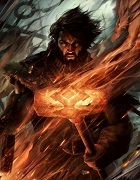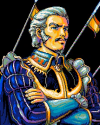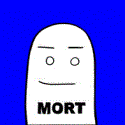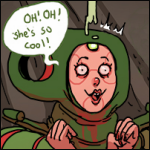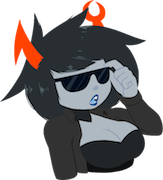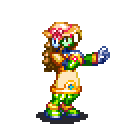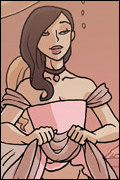- Scintilla
- Aug 24, 2010
-

I BEAT HIGHFORT
and all I got was this
jackass monkey
|
Do it, that was really good. There is a lot of oots in that write up.
Alright. This one's much longer and more detailed.
quote:Today we're going to talk about villains. When I say the word "villain," I mean a very specific kind of antagonist. Generally, I'm talking about character that not only serves an adversary, but also does so repeatedly, either in person or through his or her secondary influence. Villains usually have an ongoing agenda beyond, "I want to survive my next fight with the heroes." In other words, the ogre in the cave that you fight is not a villain, but the ogre who swears revenge on the heroes for killing his brother in the cave is.
Creating villains is easy; we've all seen enough movies to be able to whip up a threatening guy in a black cloak who wants to conquer the world. This article is about creating villains that go beyond stereotypes and clichés, and who are fully realized characters with their own internal logic and emotional depth. It also deals with ways to keep every villain you make from accidentally having the same modus operandi; you can only throw your players against so many evil clerics of evil gods who hate everything good and pure before it starts to get stale!
In the interest of making this easy for anyone to use, I'm going to go through a step-by-step procedure for creating a villain for your own campaign. Along the way, I will use a single example from my own campaign: the Fire King, a half-devil elf sorcerer/fighter.
Step X: What is the villain's race or class? I am putting this first not because I think it should necessarily be the first thing determined, but because there is no "right" time to make this choice. Sometimes, the villain will flow out of the choice of creature, other times the creature type will flow out of the villainous plot you have created. Often, you will determine bits and pieces of this as you go through the other steps.
The Fire King began as a half-fiend of some kind, but other than that, I had no preconceptions when I began working on him as to his eventual stats.
Step 1: Start with two emotions. I really believe all great characters begin with one emotion that drives them. By choosing this first, you make sure your villain will stay true to the very reason he became a villain in the first place. It's kind of a cop out after a while to have villains who are just evil for evil's sake; something had to drive them to be evil in the first place. Options for their primary driving emotion might include Anger, Angst, Greed, Jealousy, Lust, Hatred, Regret, Revenge, Shame, and Sorrow. Feel free to narrow these down as much as possible to get to the core of the villain's persona: Anger is fairly broad; Resentment is a much more specific emotion. Don't forget that "positive" emotions (such as Love or Honor) might lead to villainy as well, if taken too far.
But I did say TWO emotions. So what's the second one? The emotion you intend to inspire in your players when they encounter the villain. Not all villains need to be universally loathed by the heroes, and even those that are often have that loathing colored by another emotion.
The Fire King began with the driving emotion of Shame, with a good mix of Insecurity and Revenge. He was created from the beginning to inspire stark raving Terror in the players.
Step 2: What events in the villain's past brought about this emotion? Whatever emotion you picked, there must be a reason the villain feels that way. It does not need to be necessarily logical, and it certainly does not need to be something you personally agree with. In fact, often the villains I create will personify an emotional response that I specifically find inappropriate. Part of the fun for me is creating characters with a "twist" away from the expected reaction to the events in their past. Still, it needs to at least be consistent with responses that might be natural for someone, somewhere. The goal is to create a history that sounds reasonable when you read it, but might not be completely obvious when bits and pieces are uncovered over the course of the campaign.
I decided that the Fire King was ashamed of his half-breed status. The twist was that rather than being embarrassed for being half-fiend, he was embarrassed because he was half-something else. In his eyes, he didn't live up to the legacy of his father, a powerful fiend of some kind, because he was half-mortal. Without getting into specifics, I decided that he had been through at least one traumatic childhood meeting with other full-blooded fiends, where he was ridiculed or even attacked for his hybrid nature. I also decided that both of his parents were deceased, since it made it easier to give him that "alienated" status.
Step 3: What is the villain's scale? Decide on what level you want the villain's actions to have repercussions. Is this a villain that will only harass the heroes and their immediate friends? Is this a villain that threatens a nation? Is it a villain that threatens all of existence? The answer will depend on how often you want this villain's actions to interject into the campaign. If the entire campaign is an epic struggle against this villain, chances are he's going to need to have a scale greater than just one village. On the other hand, the greater the scale, the more likely powerful NPCs will take notice of the villain, and it becomes more difficult to justify them not swooping in to aid the heroes. This question will also help decide what Challenge Rating you should assign to the villain.
The Fire King was intended as the primary villain for the entire campaign (which ended up lasting 38 sessions). I decided he worked on a scale that threatened the entire world, but not every other plane of existence.
Step 4: What is the villain's goal? Every villain needs a final goal, no matter how grand or insignificant. Keeping in mind the villain's scale, determine what he wants to see happen. It can be as simple as wanting to be very wealthy, wanting to kill a specific person, or wanting to seize as much power as possible. Many goals are completely unattainable, such as winning a specific person's admiration or being the most powerful wizard anywhere. The villain can still cause a lot of heartache for the heroes on the path towards that goal, though. Remember that the villain only needs to believe their goal is attainable; it is not necessary that it actually be so.
I determined that the Fire King ultimately wanted to live up to his father's expectations, as well as come to dominate the full-blooded fiends who mocked him. Therefore, his final goal was to seize control of his home plane, Hell.
Step 5: What does the villain need in order to be able to achieve this goal? In order to devise an appropriate plan, it is crucial to understand what the villain thinks he needs in order to pull off the "end stage" of the plot. If the villain wants to destroy the multiverse, he needs to have some source of power that allows this. If the villain wants to drive the gnomes out of Sunlight Valley, she needs something that will make the gnomes want to leave. By visualizing what resources the villain needs in order to make the goal a reality, you firm up what steps the villain will need to take along the way. Note there will almost certainly be multiple paths to accomplish the goal, so your villain has chosen either a.) only one, or b.) to enact multiple simultaneous plans as a failsafe.
Often, the means to accomplish the goal will be fairly esoteric; feel free to make up whatever powerful artifact, lost magic, or obscure ritual you need to give the villain the tools he needs. These are the things that the players will need to stop, or delay, or what have you, and from there, adventures will be easily derived. You can also break the goal into several "subgoals," each with its own requirements.
The Fire King determined that he needed virtually unlimited magical power to accomplish his goal; at least as much power as that of the current rulers of Hell combined. To that end, he learned of a ritual to absorb all of the world's magical energy. The ritual had very stringent requirements: it could only be undertaken by a sorcerer who was genetically unique in the world and a native to that plane, but a mortal could not survive the inherent energies involved. As a native outsider, however, the Fire King was uniquely suited to the task. I would later decide, due to the high level of coincidence that this created, that his father had spawned him specifically to serve as the focus for this ritual as part of an older, failed domination plot.
Step 6: What obstacles must the villain overcome? The easy answer here is, "the heroes," but it isn't the right answer. The fact is, the heroes won't even know to oppose the villain until they encounter some other part of the plan. There needs to be something (anything) standing between the villain and his goals, or else they will be achieved with no chance for interference on the part of the heroes. Since your goal is to create opportunities for conflict, that won't fly.
Once you establish the obstacle, you can then go back to Step 5 and determine what steps need to be taken to overcome that obstacle. Then back to Step 6 for what obstacles are in the way of those steps. And so on and so forth, until you have enough steps to flesh out a fully realized plan of action.
The big stumbling block for the Fire King was the line in his ritual about being "unique." I decided being a half-fiend wasn't sufficient; he needed for his base creature type to be the only one in existence. Obviously, that was not the case currently. His solution, then, was somewhat grandiose but befitting the scale I had chosen for him: slay all creatures of the same base type, everywhere.
It was at this point that I decided he would be half elf, half devil. The elves in my campaign world are somewhat unpleasant, and I liked the idea of one villain trying to wipe out a race that others would find inherently villainous in the first place. Plus, it set up another automatic obstacle: there were certainly plenty of high-level elven wizards walking around the world, meaning that the Fire King could not simply start slaughtering elves left and right without attracting their attention.
Step 7: What is the villain's primary means of projecting influence? The final step before setting down the villain's ultimate plan is to decide what sort of actions he or she prefers to take to set things in motion. Is the villain a manipulator, turning others to his end without their knowledge? Is he a leader, convincing others to side with him through strength of personality? Does she use her own personal power to accomplish her ends or does she rely on others to do her dirty work? Does he move openly or in secret?
The Fire King was primarily a manipulator. While I decided he would be a very powerful sorcerer by this point, he was aware that if he moved openly with his plan for genocide, the heroes who would act against him would number in the dozens (or hundreds). He could not stand against that kind of power, so he worked to turn those who would interfere with his plan against one another, whittling down their power until it was safe to reveal himself.
Step 8: What are the villain's resources? This step's importance cannot be underestimated. If the villain has infinite resources available, they are essentially omnipotent. Limiting the people, places, and things the villain can successfully use to enact his will leads directly to adventures, because the villain must then use these resources in such a way that allows him or her to acquire more. Don't forget to include abstract resources, such as "genius-level intelligence" or "knowledge of the future."
I decided quickly that I would differentiate the Fire King from other stereotypical villains by sharply limiting his starting resources. This was not to be a villain with an entire organization fanatically backing him; this was a guy with the equivalent of the shirt on his back. I listed his resources as the following:
• Genius-level intelligence and a fine strategic mind
• Superb leadership and deception skills
• The power of a 12th level Red Sorcerer (that is, mostly fire-oriented spells), including appropriate magic items.
• The ability to pass in elven society without being detected as anything other than an elf, even via magic.
• The inherent tension between the human and elven civilizations, a result of centuries of enslavement in the distant past. Also, the natural dissatisfaction of the elves with the state of the world.
• A handful of minor devils who had owed loyalty to his father and were willing to throw their lot in with the son as well.
• His sister, another half-devil elf, with the skills of a 9th level rogue and a knack for seduction.
As the campaign began, he also reestablished the loyalty of another powerful villain, with his own elaborate backstory, that had worked with his father. While he later came to manipulate large armies of elves, I didn't count these as true resources because the elves were not part of his plot; they were the victims of his plot.
Step 9: If no heroes were to interfere, what would the villain's plan to achieve this goal be? Now that you know all of the goals that need to be accomplished and the primary means by which the villain intends to do exactly that, you can set down the villain's plan in loose terms. Try to not take into account the specific actions of the players; even if the villain hatches his plot with full knowledge of the heroes, he is unlikely to assume that they will defeat him. It is entirely likely, however, that he might take general steps to limit their interference.
This step is likely to produce the most work, because in effect it is an outline of the way in which the villain will interact with the heroes and the campaign world. The villain's plan might have dozens of steps to it, and each may turn into one or more adventures for the players. If you find the plot has more steps than the number of times you would like this villain to show up, simply decide that the villain has already accomplished one or more steps before the heroes are even in play. Alternately, you could have some steps occur "off-camera," but you run the risk of the heroes deciding to take steps to stop them when you really haven't planned to run that particular adventure.
The Fire King's plan began years before the heroes began adventuring. Finding his greatest asset to be his ability to work within the very society he was attempting to wipe out, the Fire King spent 20 years infiltrating the house of an elven noble, until such time as he quietly seized control of the elf's noble title. With this title, he was able to attend gatherings of the elven emperor's court, where he quickly made a name for himself with several outspoken opinions that he used his other resources to make happen exactly as he had predicted. The Fire King further endeared himself to the boy-emperor by introducing him to his half-fiend sister, who easily seduced the young elf. Soon, the emperor began listening to the Fire King's advice almost exclusively, and then the plan moved into high gear.
Whispering lies into the emperor's ears, the Fire King convinced him that the empire needed to recover past glories or die out. He began gathering and training a new elven army, which he then used to lash out at the neighboring humans, destroying border towns and killing hundreds. The emperor was easily impressed by these early victories, and ordered the invasion of a nearby human nation. The Fire King manipulated events so that only "soft" targets were attacked, lulling the elven court into believing that a full-scale war against humans could be won when he knew that the human nations were more powerful. He took control of the invading armies personally, urging elven commanders to commit horrible atrocities that would incense other nations. In this way, the Fire King hoped to provoke the humans into slaughtering the elves for him, thus achieving his goal.
Meanwhile, he began personally seeking out and eliminating threats to the plan. While the drums of war began to beat between the humans and the elves, he struck at various power centers on either side that might be able to bring the rush to war to a halt. It was through these strikes that the heroes learned of him and his plans. Had nothing gone awry, the Fire King would have struck down or manipulated those with an interest in stopping the war, allowing the humans and elves to fight it out in a bloody war to the end. Eventually, the Fire King would have been able to simply mop up the surviving elves and enact the ritual that allowed him to seize all magical power in the world. With this power at his command, he could transform the planet into a training ground for an army of billions with which he could conquer Hell.
Step 10: What are the villain's boundaries? There should be at least one thing the villain is not willing to do to achieve his goals. They may have a code of honor, or simply have a strong distaste for some kind of act. This detail will give your villain a realistic feel, as well as crossing off certain options that might be difficult for the heroes to eliminate through their actions. For example, the villain may be unwilling to traffic with demons, which helps you explain why he doesn't just summon a bunch of balors to do his dirty work.
The Fire King was intensely loyal to his friends. Growing up as basically an outcast wherever he went, he was not about to throw away friendships over something as minor as world domination. Thus, he was not ever going to betray anyone who was within his inner circle of confidence, and he did not consider any of them expendable.
Step 11: What is the villain's personal threat level? In other words, is the villain a danger to the heroes if encountered personally? How much of a danger? Some villains might be just puppeteers, capable of influencing the world but unable to stand up in a fight; think of this as the "Lex Luthor" model. Others might be equal in power to the party, while still others may be so much more powerful than the party that a direct confrontation would be suicide. This last option is ideal if you want the players to become aware of the villain long before you expect them to defeat him.
The Fire King was a serious physical threat by any standard. When first encountered, he wreaked such destruction on a village that further encounters with him prompted the heroes to simply run away. As the campaign progressed, he gained in power but at a slower rate than the heroes, so that by about the time the heroes were 12th level, he was a beatable (but still very difficult) challenge. Often, I put their encounters in the context not of direct combat, but of achieving goals. The heroes once managed to rescue an NPC that was about to rat out the Fire King's plans by being able to outrun him, for example.
Step 12: How does the villain treat his minions? How do the minions feel about the villain? Not all villains inspire loyalty to the death. Giving the villain servants who are less than blindly obedient can increase the opportunity for roleplaying, as heroes try to convince henchmen to abandon their evil ways (or at least accept a healthy bribe). Whether or not the villain treats them well will influence this decision heavily. A villain who sends his servants on suicide missions time after time had better be powerful or charismatic enough to ensure their absolute obedience, or else he will find himself on the wrong end of a mutiny.
I had already determine that the Fire King had a good relationship with his true allies, so this step was kind of redundant for him. Although I did clarify that he was willing (in fact, eager) to send as many of the elven soldiers serving in his army to their horrible deaths as he could.
Step 13: What are the villain's visual quirks? A good villain has a look that will be remembered long after the campaign is over. Once the players are aware of the villain, further direct encounters should be recognizable solely based on his look. Try finding things that distinguish him from others of his race and class. Also, methods of fighting and preferred tactics can add to the villain's style. Using a unique weapon or a favorite spell not only flesh out the character, it gives the players the opportunity to plan a countermeasure for their next meeting with the villain. The character thus becomes a part of their world in a fundamental way.
The Fire King, as his name implies, always used fire-based evocations when attacking. Because he was immune to fire himself, he enjoyed casting fireball as a melee spell. He also wore black adamantine full plate armor while doing so, which terrified the more metagaming-prone players. They spent a lot of energy figuring out how he was able to cast arcane spells in armor, which kept him alive in their thoughts even when he was not "on-screen".
Step 13a: What would the villain's theme music sound like? OK, this one really isn't a necessary step, but it's one that helps me imagine the villain properly. Whether you intend to actually play it during the game or not, come up with a song or orchestral piece that evokes the emotional impact of the villain. I've found that playing the song for myself before I DM a game where the villain makes an appearance helps me roleplay him.
If you've ever played Final Fantasy 8, you have heard the Fire King's theme music. I chose the theme from one of that game's early villains (Edea, who later becomes a friend) as the Fire King's theme because I felt it represented the right mixture of cunning manipulation and raw personal power. As the driving force behind a massive elven army that was marching to its untimely end, the piece's chanting helped convey to me a sense of impending doom. To this day, I think of the Fire King when I hear it, not Final Fantasy 8.
Step 14: What is the villain's escape plan? This is semi-optional too, but if you intend to have the players encounter a villain repeatedly without a decisive victory, you need to think about it. I cannot emphasize, however, that such a plan needs to be keeping within the rules of the game AND within the villain's reasonable expectations for the future, or else your player's will cry foul. Just having the villain run away and not letting the players follow feels cheap. On the other hand, if your villain is a powerful wizard, making sure he prepares at least one teleport for those sticky situations is not only helpful; anything less would be foolhardy. Even then, it is usually helpful to have such an emergency plan come with a price: the villain must abandon his goal or one of resources to save his own skin. Thus, even when he escapes, the heroes have earned a victory.
Early in the game, the Fire King was so much more powerful than the heroes that he didn't run from them, they ran from him. As time went on, he learned to teleport away once he could no longer accomplish his goal.
Step 15: What is the villain's name? Trickier said than done, coming up with a good name can make or break a villain. Anything that can be easily mocked will lessen his impact. Anything too complex will lower the chance that the players can remember it, and they can't fear what they can't remember. Ideally, a good name should inspire respect. Also, give some thought as to when you will reveal the villain's name; during their first meeting, or at some later point?
I decided at this point that this character didn't need a name as much as he needed a title; a self-proclaimed station to attempt to live up to. With his inherent embarrassment over his elven blood, he would seek to escape from whatever name he had been given by his mortal mother and forge a new identity for himself. Hence, I named him the Fire King, which I thought had the right sense of dominance without actually being a real title. Of course, this was his name for himself, and he used a different title when among the elves. Early on, the heroes had no idea what his name was at all, and referred to him simply as the Red Wizard (they didn't know he was a sorcerer) for months.
By this point, you should have a very good idea of who your villain is and what he needs to do in your game. With all of the plotting you have done so far, you should have created the rough framework from which you can build a series of adventures without having any foregone conclusions or railroading. By understanding the villain and his aims, you can have him or her organically alter their plans based on how the heroes manage to thwart sections of it, all without pre-ordaining the outcome.
As a way of working further on these issues, I'm going to go and create a completely new villain over on the message board, using this checklist as a guide. If you enjoyed this article, I encourage you to enter the Villain Design Contest I am going to hold on the message board; feel free to use either these guidelines or your own methods to come up with the most badass bad guy ever.
Next time, I'll talk about texture for players (rather than DMs), also known as "How to Have Seven Classes and Have Each of Them Make Sense."
Unfortunately these are the only two articles I thought to save. Still, they provide an interesting insight into how Rich designs his villains, especially when comparing the Fire King to Redcloak.
|







